Abstract
In this study, failure of the cone of a reactor in an ethylbenzene unit of a petrochemical complex has been investigated. The material of the cone was found to be ASME A240 Type 304H which was severely corroded at elevated temperature. The study of the microstructure of the material showed the occurrence of carburization which led to sensitization and resulted in corrosion of the material. The result of the microhardness testing and double-loop electrochemical polarization investigation proved the diffusion of carbon through the material and occurrence of sensitization.





Similar content being viewed by others
References
V. Zarubina, C. Nederlof, B. Van der Linden, F. Kapteijn, H. Heeres, M. Makkee, I. Melián-Cabrera, Making coke a more efficient catalyst in the oxidative dehydrogenation of ethylbenzene using wide-pore transitional aluminas. J. Mol. Catal. A-Chem. 381, 179–187 (2014)
Damage mechanisms affecting fixed equipment in the refining industry, API recommended practice 571, American Petrolium Institute, Washington (2011)
H. Grabke, I. Wolf, Carburization and oxidation. Mater. Sci. Eng. 87, 23–33 (1987)
H.M. Tawancy, A. Ul-Hamid, N.M. Abbas, Practical engineering failure analysis (CRC Press, London, 2004)
Specification for heat resisting chromium and chromium–nickel stainless steel plate, sheet, and strip for pressure vessels, SA240, American Society of Mechanical Engineers
A.H. Vol, 9: Metallography and Microstructures (ASM International, Materials Park, OH, 2004)
M. Prohaska, T. Wernig, J. Perek, G. Mori, G. Tischler, R. Grill, Application of the DL-EPR method for detecting sensitization to intergranular corrosion in thermomechanically rolled corrosion-resistant alloys 316L, 825L and 926L, 2nd International Conference Corrosion and Material Protection, Prague, Czech Republic, 19–22 April 2010, 1–8
D.J. Young, High Temperature Oxidation and Corrosion of Metals (Elsevier, Amsterdam, 2008)
O. Shekhah, R. Schlögl, K. Christmann, Styrene synthesis: in-situ characterization and reactivity measurements over unpromoted and potassium promoted iron oxide model catalysts (Freie Universität Berlin, Berlin, 2004)
W. Jae Lee, G.F. Froment, Ethylbenzene dehydrogenation into styrene: kinetic modeling and reactor simulation. Ind. Eng. Chem. Res. 47, 9183–9194 (2008)
D.E. Resasco, Dehydrogenation Heterogeneous, Encyclopedia of Catalysis (Wiley, London, 2002)
G.R. Meima, P.G. Menon, Catalyst deactivation phenomena in styrene production. Appl. Catal. A-Gen. 212, 239–245 (2001)
Author information
Authors and Affiliations
Corresponding author
Rights and permissions
About this article
Cite this article
Javidi, M., Ghassemi, A. Failure Analysis of a Reactor in Ethylbenzene Unit. J Fail. Anal. and Preven. 17, 228–234 (2017). https://doi.org/10.1007/s11668-017-0233-3
Received:
Revised:
Published:
Issue Date:
DOI: https://doi.org/10.1007/s11668-017-0233-3




